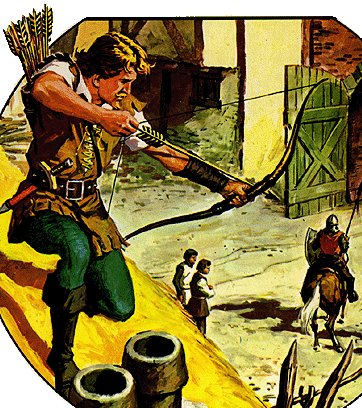 Real
Name: Unsure - records suggest Robert Hode/Robyn Hode, but most later
stories go with either Robin of Locksley or Robin, Earl of Huntingdon
Real
Name: Unsure - records suggest Robert Hode/Robyn Hode, but most later
stories go with either Robin of Locksley or Robin, Earl of Huntingdon
Identity/Class: Normal human
Occupation: Outlaw ("Wolfshead")
Affiliations: his "Merrie Men" (including, but not limited to Little John, Will Scarlet, Friar Tuck, Much the Miller's Son, Allan a Dale, "Maid" Marion)
Enemies: Sheriff of Nottingham, Guy of Guisborne, Abbot of St. Mary's - York, Bishop of Hereford, Prince John, Isembart de Baleme, Simon de Belleme.
Known Relatives: Marion (wife), Will Scarlet (possibly cousin or nephew); Elizabeth of Staynton (possible aunt, Prioress of Kirklees)
Aliases: Rob In the Hood, The Hooded Man, Hobbehod, Robin of Locksley, Robin of Loxley, Robert of Huntingdon (or Huntington). He once disguised himself as a fisherman called Simon over the Lee.
Base of Operations: Sherwood Forest, Nottinghamshire; Nottingham; Barnsdale, Yorkshire; Loxley.
First Appearance: c.1200 -1400 A.D., although modern stories of Robin now tend to place him around 1194, the year King Richard returned to England (see comments)
Powers/Abilities: One of the best archers and woodsmen in England, if not the world.
History: Robin Hood was an outlaw who reputedly lived in the area of Sherwood Forest (although some accounts dispute this and place him further afield). Alongside his band of fellow outlaws, some nearly as famous as he, folk tales saw him robbing the rich (often in the form of stealing tax money) and giving to the poor (e.g. returning said tax money to the people who paid it in the first place). Though early ballads place suggested he was active around the time of King Edward (either 1272-1377, depending on whether it was Edward I, II or III), later versions of the tales backdated him to around the time of King Richard the Lionheart (1189-1199) during the period when Richard was held hostage on his return from the Crusades, and Prince John was on the throne as regent.
Allen Wright expands on this: There have been several possible candidates for a real Robin Hood. One historical Robin Hood is the Robert Hod, fugitive (aka Hobbehod) who is listed on the Yorkshire assize rolls circa 1225. Dr. David Crook has suggested this may be another name for the outlaw Robert of Wetherby who was active during the same time. Another prominent candidate for a real Robin Hood is the Robyn Hood who served as a porter to King Edward II during 1324. This Robyn made be the same person as Robert Hood, a landowner in Wakefield, Yorkshire in 1316-1317. Also, from 1262 onwards, various criminals have been assigned combined surnames such as Robehod, suggesting a reference to the legend. The legendary Robin Hood has borrowed elements from the fictional exploits of other real-life outlaws such as Fulk Fitz Warin, Eustace the Monk and William Wallace.
The first clear literary reference to Robin's legend comes in an allusion to the "rymes" of Robin Hood, made in the B-Text of Piers Plowman (circa 1377.) Manuscripts of ballads survive from about 1450, with early printed ballads appearing circa 1500. Also, in 1427 Exeter held May Games with a Robin Hood element. Robin Hood Games or Plays appeared in many English and Scottish villages in May and June, during the 15th, 16th and 17th centuries.
The Robin Hood legend has changed over the years. In the early ballads, Robin is a yeoman - a member of the middle class. But by the time of Queen Elizabeth I, Robin is said to have been the earl of Huntingdon. Although always a robber, Robin's tendency to give to the poor was something of a later addition too.
The original ballads don't say why Robin Hood was outlawed. Later stories have had him outlawed for debts or defending himself or a peasant from foresters or having his lands unjustly stolen by Prince John or some other villain.
The earliest surviving ballads do feature plot points that still appear in the modern books and films. Robin Hood robbed monks from the abbey of St. Mary's. He robbed from the sheriff of Nottingham. Robin won an archery contest in Nottingham (later stories have him disguised, and added the moment where he splits the arrow.) And in A Gest of Robyn Hode and Robin Hood's Death, the outlaw was bled to death at Kirklees Priory in Yorkshire.
Comments: Thanks to Allen Wright for providing information for this page. Check out his Robin Hood website. Allen notes "To clarify the issue, most Robin Hood stories written these days are set circa 1194 (the year that King Richard returns to England). However, the early ballads are oblique on that subject and were apparently set in a later time. (The king is named Edward in one ballad.)
There are a various amount of real Robin Hoods, probably the two most widely accepted ones date from 1225 (Robert Hode, fugitive, aka Hobbehod, and sometimes thought to be the same as a Robert of Wetherby) and Robert Hode/Robyn Hode from the early 1300s - first holding land in Wakefield, and later in service to the king (Edward II).
The first clear literary reference to the legend occurs in the B-Text of Piers Plowman, published circa 1377. The earliest surviving ballads date from about 1450-1460. ("Robin Hood and the Monk" was published around this time, with "Robin Hood and The Sheriff" being published c.1475 and "Robin Hood and the Potter" c.1500)
Some ballads and novels say that Robin Hood was either Will Scarlet's cousin or uncle. Robin Hood was a yeoman in his earliest ballads, but later stories have depicted him as an earl or a knight."
Allen's information ties in with other records - a "Robin Hood" is named in Folio 103 of the Registrum Premonstratense in 1304 (tying in with Allen's mention of Robert Hode), while in 1341 the canon of Aberdeen, John Fordun, dates Robin's exploits as around 1266. This ties in with the Battle of Evesham which was fought around 1265, some 80 miles from Nottingham. Some suggest that Robin fought at this battle against the then king, Henry III, and was thus outlawed. Backing this supposition are accounts that Sheriff of Nottingham William de Grey fought a number of battles against outlaws hiding in Sherwood in 1266.
For more information on the legends and the historical Robin, check out either
http://www.robinhood.info/robinhood/index.html
Robin is the forebear of such comic characters as the Green Arrow and Hawkeye. Allen Wright's site has a number of excellent pages about Robin's comic book exploits, so rather than trying to repeat or reproduce his work, I direct the interested to his pages on the topic:
Robin Hood Tales (Quality and D.C. Comics)
As well as a number of folk tales (often distorted over the years), as well as novels (each putting their own spin on the legend), there have been a number of movies which have produced their own incarnation of the famed outlaw. Much as with vampires or Sherlock Holmes, where an idea introduced in a movie or play became iconic and adopted by tales which followed (vampires' problems with sunlight come from the movie "Nosferatu", not the novel "Dracula", while Holmes deerstalker and curled calabash pipe owe more to the movies (former) and actor William Gillette (latter) than the Conan Doyle stories), these later adaptions of the old legend have often left an indelible mark on the public perception of Sherwood's outlaw.
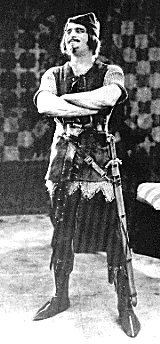
The first ever Robin Hood movie (that I am aware of) was a 1912 release, where Robin was played by Robert Frazer. A year later William Russell played Robin in a UK movie, "Robin Hood and Maid Marion". However it was the 1922 Robin Hood which saw Douglas Fairbanks (right) play Robin, the former Earl of Huntingdon, which marked the first major cinematic outing for the character, and established the character wearing tights and a pointy hat for some time to come.
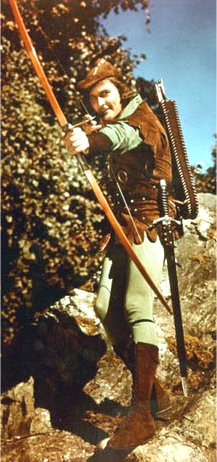
The next iconic Robin was provided by "The Adventures of Robin Hood" in 1938, starring Errol Flynn. This time round, he was Sir Robin of Locksley, though otherwise this version was a lot like Fairbanks'. Interestingly, James Cagney was originally meant to play Robin, but quit the studio, allowing Flynn to eventually take the role.
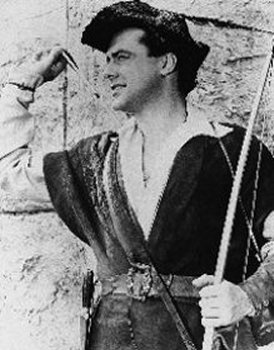
Flynn appears to have been such an iconic Robin that it was a while before anyone made another serious attempt to do a definitive take on the legend. Disney did a live action movie "The Story of Robin Hood and His Merrie Men" starring Richard Todd (later to become better known for Dambusters) in 1952, while Patrick Troughton, later to play the second Doctor, was Robin Hood for six episodes of a BBC adaption in 1953, but it was their rivals at ITC who produced the first television version which left a true mark, when they launched "The Adventures of Robin Hood" in 1955. The show ran until 1960, a total of 143 half-hour episodes, and Richard Greene's Robin of Locksley got through two Maid Marions during his time on air. Even today, the show's catchy theme tune remains a well-known jingle:
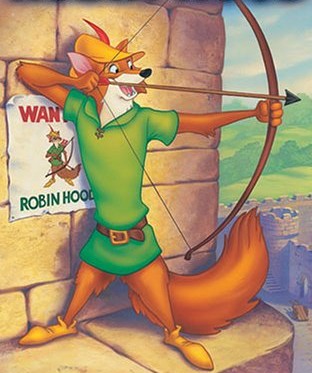
Disney released their feature length cartoon of Robin Hood in 1973. Not the first animated version, it however remains the definitive one with Brian Bedford's fox Robin probably being more recognisable to many people than the human actors who have played the role.
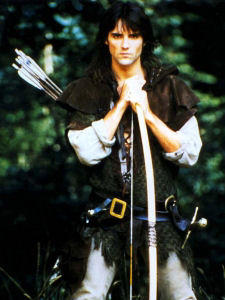
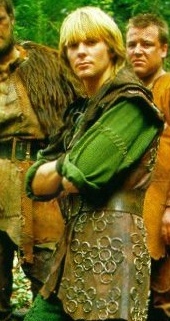 Sean Connery played an aged Robin at the end of his life in
1976's "Robin and Marion", but television was to be the home of the next
major Robin. "Robin of Sherwood" by Richard Carpenter ran for three seasons
from 1984, adding magic to the mix and finally getting Robin out of tights.
A change in leading actor led to two Robins of legend being used; Robin of
Locksley (played by Michael Praed) died at the end of the second season,
to be replaced by Robert of Huntingdon (Jason Connery). Both men were
chosen for the role of outlaw leader and people's resistance fighter by Herne
the Hunter, a mystic being who lived deep in Sherwood. Notably, the show's
addition of Nasir, a Hashashin warrior, seems
to have impacted on the legend, with variations on the character appearing
in Costner's "Prince of Thieves" (Azeem), "Men
in Tights" (Ahchoo), "The New Adventures of Robin Hood" (Kemal), and the
BBC's "Robin Hood" (Djaq) - all discussed below.
Sean Connery played an aged Robin at the end of his life in
1976's "Robin and Marion", but television was to be the home of the next
major Robin. "Robin of Sherwood" by Richard Carpenter ran for three seasons
from 1984, adding magic to the mix and finally getting Robin out of tights.
A change in leading actor led to two Robins of legend being used; Robin of
Locksley (played by Michael Praed) died at the end of the second season,
to be replaced by Robert of Huntingdon (Jason Connery). Both men were
chosen for the role of outlaw leader and people's resistance fighter by Herne
the Hunter, a mystic being who lived deep in Sherwood. Notably, the show's
addition of Nasir, a Hashashin warrior, seems
to have impacted on the legend, with variations on the character appearing
in Costner's "Prince of Thieves" (Azeem), "Men
in Tights" (Ahchoo), "The New Adventures of Robin Hood" (Kemal), and the
BBC's "Robin Hood" (Djaq) - all discussed below.
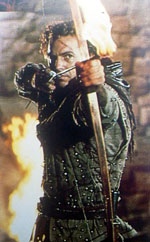
The next big screen adaption to make an impact was 1991's "Robin Hood: Prince of Thieves", with Kevin Costner as Robin of Locksley, a former Crusader who returns home to find his father murdered by the corrupt sheriff. This Robin also later discovers that Will Scarlet is his half-brother.
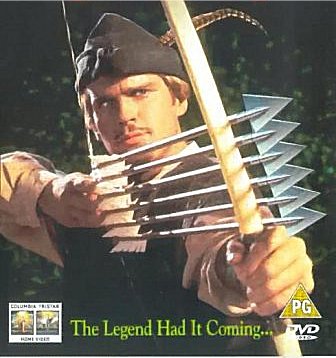
Honourable mention should go to Patrick Bergen as Sir Robert Hode, a.k.a. Robin Hood. Released the same year as Costner's movie, but sadly overshadowed by it, "Robin Hood" remains a spirited attempt to bring a realistic depiction of the character to the screen. Not so realistic was Mel Brooks send up of Costner's movie, when in 1993 he released "Robin Hood: Men in Tights", starring Cary Elwes as a comic version of Robin. And in 1997, the TNT Network attempted to cash in on the Xena/Hercules bandwagon, and produced the truly abysmal "The New Adventures of Robin Hood". Matthew Porretta played Robin to begin with, but was replaced after a couple of seasons by John Bradley.
From 2006 to 2009 the BBC broadcast a new incarnation of the outlaw, this time played by Jonas Armstrong. Once again a Saracen character was introduced to add some diversity to the cast, though this one, Djaq (played by Anjali Jay) differed from her predecessors by being female. And in 2010 Robin had a new big-screen outing, simply titled "Robin Hood", with Australian actor Russell Crowe playing "Robin Longstride."
Robin has also made a number of cameos over the years - among them his appearance in "Time Bandits" played by John Cleese, and later in "Blackadder Back and Forth" played by Rik Mayall. Daffy Duck played his own version of Robin in a cartoon alongside Porky Pig's Friar Tuck, and a parody, Monsieur Hood (voiced by Vincent Cassel), made an appearance in "Shrek".
Thanks to Janet Clarke for bringing Richard Todd to my attention.
CLARIFICATIONS: None.
Any Additions/Corrections? Please let me know.
Back to Historical and Mythical Heroes
All images and characters depicted are copyright their respective holders, and are used above for informational purposes only. No infringement is intended and copyrights remain at source.